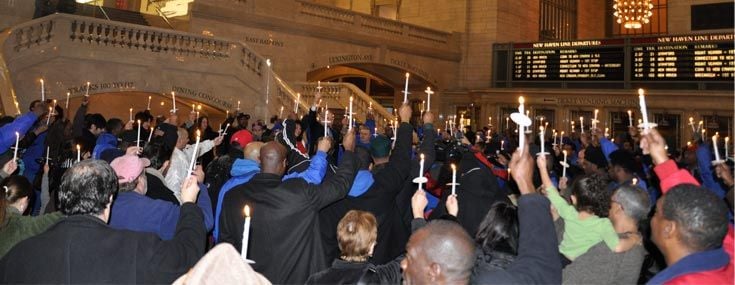
Newsroom
| < Return To News Archive | |
| August 30, 2011 | |
| Doe Fund Cleans Streets and Lives | |
The Peter Jay Sharp Center for Opportunity helps the homeless start over | |
by Paul Cox | |
  Photo by Paul Cox for The Bushwick News/BushwickBK The Doe Fund operates out of this renovated knitting factory on Porter Avenue. "I went to some orientations and was told exactly what the Doe Fund had to offer," Black recalls, "which is basically a hand up and not a handout. They help you get back on your feet." A year later, he is. Now certified in building maintenance and computers, Black is working for Palladia, one of the city’s largest social service agencies. He’s just moved into a new Manhattan apartment.  The Doe Fund's building on Porter Avenue. The Doe Fund’s work-driven formula has gone in and out of policy fashion in its twenty years (as have the needs of the homeless; initial city support to the Fund was slashed by Giuliani) but this year its results have brought it to the federal agenda. Ready, Willing & Able was one of seven programs nationwide chosen by the Department of Labor to provide its services to new parolees. The Fund will take on more new participants from Upstate, and the Department of Labor will monitor the results with an eye to replicating successes at a national level. Under a $5.6 million grant – a small miracle in a year of federal budgetary limbo – the new program will be run out of the Porter Avenue center. The Peter Jay Sharp Center for Opportunity fills the last block of Porter Avenue – what was originally, like many of the surrounding buildings, a huge knitwear factory. The building was derelict in 2003 when the Fund converted it, but the new owners paid homage to the neighborhood’s past with a painted sign spanning the face of the building in classic 1920s Brooklyn industrial style. The complex shines inside and out, from a wood-paneled library, to a kitchen where trainee chefs prepare fresh meals, to computer learning labs and a quiet roof terrace. William Black spent much of his year on Porter working his way through a course in Advanced Building Maintenance. "A very intense course," he says, "but it got me all sorts of certifications: electrical, carpentry, even green building maintenance." He also learned professional computer skills from scratch, joined Narcotics Anonymous, and took classes in financial management with Bushwick’s Brooklyn Cooperative Federal Credit Union. But like all participants he started off in a blue t-shirt with the street crews, "pushing a bucket" around Midtown and East Williamsburg’s own Graham Avenue. Even that was an experience Black values. "Pushing a bucket kinda humbles you, gives you time to think about where you been, where you are, and what you want to do with your life." The Doe Fund also started off with the dirty work when it came to the neighborhood eight years ago. The outpost was established in a less than auspicious address, a shell of a factory in a rough neighborhood. Even after its conversion into the Peter Jay Sharp Center, the surroundings were hardly wholesome; Johnson Avenue was then an open marketplace for drugs and prostitution. But the newcomers pushed to make a space for themselves, first with help from the 90th Precinct and later with the benefit of an unexpected shift in the neighborhood’s character. Today, loft-dwellers jog past the complex every morning and the ex-warehouse on the other side of Porter buzzes with activity as the arts and music hub Brooklyn Fire Proof. "Now they’re calling this area Morgantown, and we’re proud of that," says Program Director Thomas Perry. "Eight years ago it wasn’t the kind of place that had a name. We like to think we played some small part in making it better." While the neighborhood is getting easier to live with, the center is still a world of its own. William Black didn’t see much of East Williamsburg or Bushwick during his year here: "I was focused on what I came there for. I came in there to fix my life, get an apartment, and move forward again," he says. "You’d have had to melt me and pour me out of there. I was determined to do what I came for." | |
| < Return To News Archive | ^ back to top |